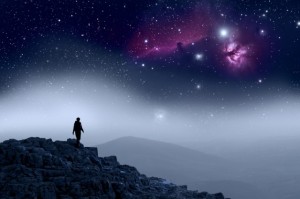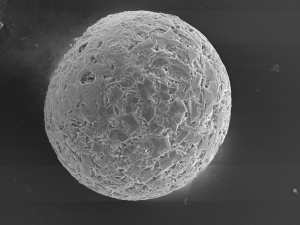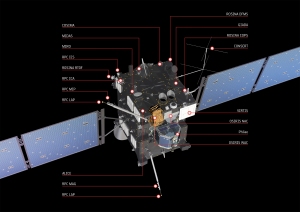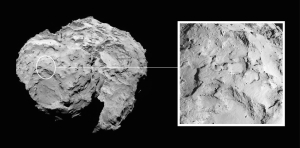An image of the surface of comet 67P/Churyumov-Gerasimenko worth a thousand words

Credits: ESA/Rosetta/MPS/UPD/LAM/IAA/SSO/INTA/UPM/DASP/IDA
Space news (solar system science: planetary science; cometary science) – 66 feet above the surface of comet 67P/Churyumov-Gerasimenko; in a controlled descent –
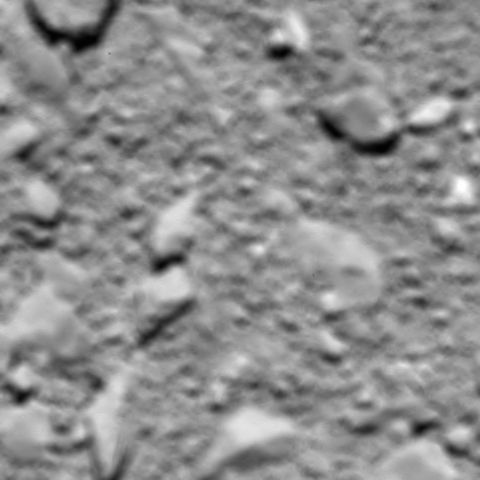
Credits: ESA/Rosetta/MPS for OSIRIS Team MPS/UPD/LAM/IAA/SSO/INTA/UPM/DASP/IDA
The image above is the last thing the OSIRIS narrow-angle camera aboard the European Space Agency”s (ESA)Rosetta spacecraft captured before it hit the surface of comet 67P/Churyumov-Gerasimenko at 4:19 a.m. PDT (7:19 a.m. EDT/1:19 p.m. CEST) on September 30, 2016. During this controlled crash landing of the first spacecraft in history to rendezvous and escort a comet as it orbits the Sun. Astronomers were able to conduct an additional study of the gas, dust and plasma environment close to the surface of the comet and take these high-resolution images.

Credit: ESA/Rosetta/MPS for OSIRIS Team MPS/UPD/LAM/IAA/SSO/INTA/UPM/DASP/IDA
The OSIRIS narrow-angle camera also captured the image shown at the top of the page from a height of around 10 miles (16 kilometers) from the surface of comet 67P/Churyumov-Gerasimenko. This image spans a distance of around 2,000 feet (614 meters) across the comet’s icy and volatile surface. Attempting to walk across such a surface as Bruce Willis and his drilling crew did in the movie Armageddon is going to be tricky at best.
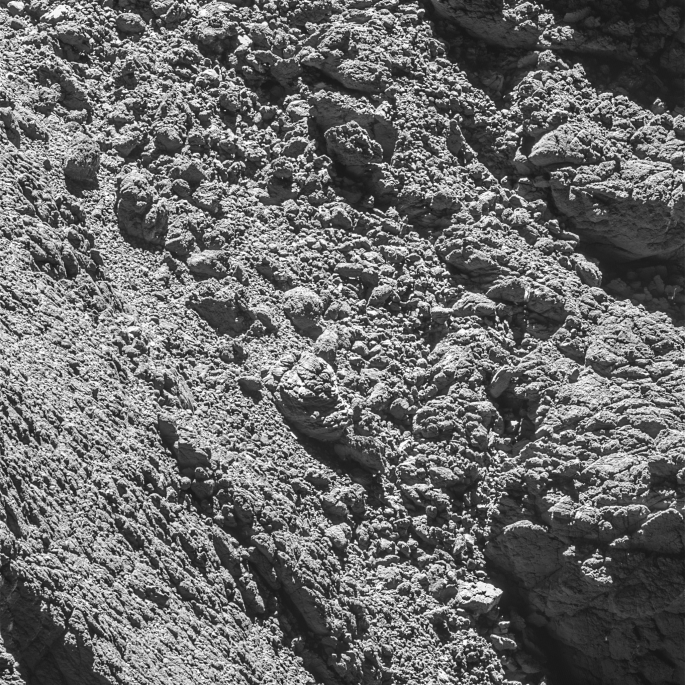
Credit: ESA/Rosetta/MPS for OSIRIS Team MPS/UPD/LAM/IAA/SSO/INTA/UPM/DASP/IDA
It might seem like a waste to purposely crash the Rosetta spacecraft on comet 67P/Churyumov-Gerasimenko, but in the end, it’s probably the best solution. This comets headed out beyond the orbit of Jupiter, which is further from the Sun than the spacecraft has traveled before, and there wouldn’t be enough solar power to operate its systems. Communicating with the spacecraft’s also about to become difficult for a month, with the Sun being close to the line-of-sight between Earth and Rosetta during this time period.

The image is a zoom from a wider-scene, and has been interpolated.
More information: Philae found!
Credit: ESA/Rosetta/MPS for OSIRIS Team MPS/UPD/LAM/IAA/SSO/INTA/UPM/DASP/IDA
Rosetta mission complete
Feel happy for Rosetta and team, they both did the job, and then some in the end. It took a decade of careful planning and travel to rendezvous with comet 67P/Churyumov-Gerasimenko and write history. Just one month and two days later, a smaller lander named Philae touched down on the surface of the comet. It bounced on the surface a few times, before finally setting down. During the next few days, it took the first images ever of a comet’s surface up close and sent back important data planetary scientists will use to look for clues to the role comets played in the formation of the planets 4.5 billion years ago. Clues they hope to use to learn more about the origin and evolution of our solar system and possibly the formation of solar systems in general.

From left to right:
Dongsuk (Don) Han- Outer Planet Navigation
Bruce Tsurutani – Rpc-mag
Essam Heggy – Consert
Sam Gulkis – Miro
Danny Tran – Aspen
Josh Doubleday – Aspen
Gregg Rabideau – Aspen
Tim Koch – Miro
Martina Troesch – Software
Barbara Hesselgesser – Acquisitions
Paul Von Allmen – Miro
Belinda Arroyo – DSN
Sophia Lee – Scheduling
Paul Friz-Rosetta Shadow Project
Liz Barrios – Illustrator
Paul Springer – Miro
Steve Chien – Aspen
Cynthia Kahn-Former SE
David Delgado – Public Engagement
Claudia Alexander – Project Scientist
Grant Faris – MA
Shyam Bhaskaran – NAV
Mark Hofstadter – Miro
Seungwon Lee – Miro
Lei Pan – Miro
Jacky Bagumyan – Assistant
Adans Ko – MA
Sarah Marcotte – Mars consultant
Charlene Barone – Rosetta Web Project Lead
Dan Goods – Creative Director
Virgil Adumitroale – Miro
Richard Flores – Acquisitions
Artur Chmielewski – Rosetta Project Manager
Veronica McGregor – Social Media
Credits: NASA/JPL
Watch this YouTube video of the last few hours of ESA’s Rosetta mission.
Read and learn more about planetary scientists anticipation of studying a sample of material from the surface of comet 67P/Churyumov-Gerasimenko, material left over from the early moments of the birth of the solar system.
Read about comet 67P/Churyumov-Gerasimenko.
Prepare to journey to comet 103P/Hartley.
Join the space journey of NASA.
Learn more about comet 67P/Churyumov-Gerasimenko here.
Read and learn more about the discoveries of the Rosetta spacecraft.
Learn more about the work of the ESA.
Read and learn more about comets here.


